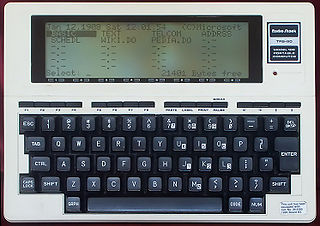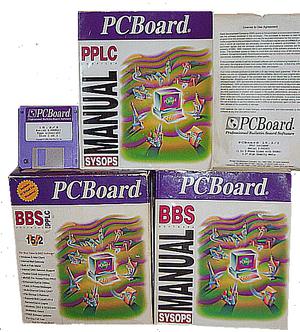Related Research Articles

A bulletin board system (BBS), also called a computer bulletin board service (CBBS), is a computer server running software that allows users to connect to the system using a terminal program. Once logged in, the user performs functions such as uploading and downloading software and data, reading news and bulletins, and exchanging messages with other users through public message boards and sometimes via direct chatting. In the early 1980s, message networks such as FidoNet were developed to provide services such as NetMail, which is similar to internet-based email.
FidoNet is a worldwide computer network that is used for communication between bulletin board systems (BBSes). It uses a store-and-forward system to exchange private (email) and public (forum) messages between the BBSes in the network, as well as other files and protocols in some cases.

CBBS was a computer program created by Ward Christensen and Randy Suess to allow them and other computer hobbyists to exchange information between each other.
U.S. Robotics Corporation, often called USR, is a company that produces USRobotics computer modems and related products. Its initial marketing was aimed at bulletin board systems, where its high-speed HST protocol made FidoNet transfers much faster, and thus less costly. During the 1990s it became a major consumer brand with its Sportster line. The company had a reputation for high quality and support for the latest communications standards as they emerged, notably in its V.Everything line, released in 1996.
An online service provider (OSP) can, for example, be an Internet service provider, an email provider, a news provider (press), an entertainment provider, a search engine, an e-commerce site, an online banking site, a health site, an official government site, social media, a wiki, or a Usenet newsgroup.
In a bulletin board system (BBS), a door is an interface between the BBS software and an external application. The term is also used to refer to the external application, a computer program that runs outside of the main bulletin board program. Sometimes called external programs, doors are the most common way to add games, utilities, and other extensions to BBSes. Because BBSes typically depended on the telephone system, BBSes and door programs tended to be local in nature, unlike modern Internet games and applications.
Synchronet is a multiplatform BBS software package, with current ports for Microsoft Windows, Linux, and BSD variants. Past versions also ran on MS-DOS and OS/2, but support for those platforms were dropped in version 3.0.

The TRS-80 Model 100 is a notebook-sized portable computer introduced in April 1983.

Diversi-Dial, or DDial was an online chat server that was popular during the mid-1980s. It was a specialized type of bulletin board system that allowed all callers to send lines of text to each other in real-time, often operating at 300 baud. In some ways, it was a sociological forerunner to IRC, and was a cheap, local alternative to CompuServe chat, which was expensive and billed by the minute. At its peak, at least 35 major DDial systems existed across the United States, many of them in large cities. During the evening when telephone rates were low, the biggest DDial systems would link together using Telenet or PC Pursuit connections, forming regional chat networks.

PCBoard (PCB) was a bulletin board system (BBS) application first introduced for DOS in 1983 by Fred Clark's Clark Development Company. PCBoard was one of the first commercial BBS packages for DOS systems, and was considered one of the "high end" packages during the rapid expansion of BBS systems in the early 1990s. PCB was used as the basis of some of the largest bulletin board systems of the era, like Canada Remote Systems.
CompuServe CB Simulator was the first dedicated online chat service that was widely available to the public. It was developed by a CompuServe executive, Alexander "Sandy" Trevor, and released by CompuServe on February 21, 1980, as the first public, commercial multi-user chat program.

Compunet was a United Kingdom-based interactive service provider, catering primarily for the Commodore 64 but later for the Amiga and Atari ST. It was also known by its users as CNet. It ran from 1984 to May 1993.
Canada Remote Systems, or simply CRS, was a major commercial bulletin board system located in the Toronto area. It was one of the earliest commercial systems outside the "big iron" companies such as CompuServe or The Source. At times it was the among the largest BBS systems in the world, often trading that position with the US-based Exec-PC, based on the number of telephone lines and its 10,000 user subscriber base. It won the 1992 Readers Choice award in Boardwatch Magazine. It survived into the 1990s, before being overwhelmed by the Internet and closing down.
ASCII Express, also known as AE, is a telecommunications software developed specifically for the Apple II personal computers. Throughout the 1980s, ASCII Express garnered a reputation as the preferred programme among telecommunications enthusiasts and users. Its functionality and compatibility with the Apple II made it a staple in the early computer communications era.
Blue Board is a bulletin board system software created by Martin Sikes (1968–2007) for the Commodore 64 in the 1980s in Vancouver, British Columbia, Canada, and sold worldwide. Due to optimized code and memory allocation, Blue Board boasted very fast performance for a BBS on that hardware platform. In fact, Blue Board was faster than most if not all BBSs run on 8-bit computers. This speed combined with its use of the ASCII character set and XModem file transfer protocol rather than PETSCII and the Commodore-specific Punter protocol sometimes led users to believe that they were calling a BBS running on a much larger and faster computer.
GT Power is a bulletin board system (BBS) and dial-up telecommunications/terminal application for MS-DOS. It was first introduced in the 1980s by P & M Software, founded by Paul Meiners. GT Power can be used both to host a BBS as well as to connect to other BBS systems via its full-featured dial-up "terminal mode". GT Power was a shareware package that required a registration fee in order to access its proprietary network mail transport/handling software and, by default, the GT Power Network. The software is distributed in two "flavors": a terminal-only version, nicknamed GTO, and the full-featured host and terminal version.
StarDoc 134 is a Dos/Linux hybrid BBS running EleBBS maintained by Andrew Baker aka "RamMan, Dotel and Dotelpenguin".

A modulator-demodulator, commonly referred to as a modem, is a computer hardware device that converts data from a digital format into a format suitable for an analog transmission medium such as telephone or radio. A modem transmits data by modulating one or more carrier wave signals to encode digital information, while the receiver demodulates the signal to recreate the original digital information. The goal is to produce a signal that can be transmitted easily and decoded reliably. Modems can be used with almost any means of transmitting analog signals, from LEDs to radio.
The Gay and Lesbian Information Bureau (GLIB) was a Bulletin Board System (BBS) and non-profit active from 1986 to 1999, and a website active from 1999-2001. It served as a "communications resource primarily serving the Lesbian, Gay, and Bisexual community". It was run by Jon Larimore and a group of volunteers with support from the Community Educational Services Foundation (CESF). It was based in Arlington, Virginia.
References
- ↑ Rickard, Jack (December 1995). "YOUR NOVEMBER EDITORIAL". Letters to the Editor. Boardwatch Magazine. Littleton, Colorado: Jack Rickard. Retrieved 14 December 2023.
- ↑ "ESOFT ANNOUNCES ENHANCED CHAT FACILITIES FOR TBBS". Internet Archive. Boardwatch Magazine. pp. 42–44. Retrieved 2 April 2023.
- ↑ "Google Groups". google.com. Retrieved 25 June 2016.
- ↑ "Scholarly Information Centers in ARL Libraries". Association of Research Libr. 1 January 1991. Retrieved 25 June 2016– via Google Books.
Sources
- Scholarly information centers in ARL libraries By Association of Research Libraries. Systems and Procedures Exchange Center June 1991.